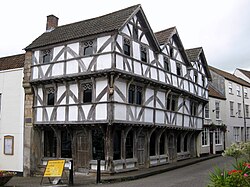King John's Hunting Lodge
| King John's Hunting Lodge | |
|
National Trust | |
|---|---|

| |
| Grid reference: | ST430545 |
| Information | |
King John's Hunting Lodge is a wool-merchant's house of around 1460 in Axbridge in Somerset. It has never been a hunting lodge nor has it belonged to King John, nor was it yet built in his time, but apart from that it is a well-named house.
The house is a Grade II* listed building.[1]
The building is of three storeys, timber-framed and occupies a corner plot on the town square. It was originally a merchant’s house, but deteriorated until the 20th century when it was bought by Miss Ripley an antique collector bequeathed it to the National Trust, and repairs where then undertaken.
The house is still owned by the National Trust who lease it to Axbridge and District Museum Trust who operate it as a local museum. It includes exhibits relating to local geology and history.
History
In 1340 a building with shops occupied the site on which the building now stands; it belonged to John Oldeway and was called "the stockhouse".
The current jettied building, which was constructed around 1460, comprised shops on the ground floor, living areas and workshops on the first floor, and storage and sleeping areas on the second floor. Jettying is a building technique used in mediæval timber-frame buildings in which an upper floor projects beyond the dimensions of the floor below. On the first and second floors curved brackets can be seen which support the floor above.[1] The structure is based around a single wooden post, known as a king post which supports horizontal beams and floor boards at each level.
This house is the finest of a number of wood-framed houses in the High Street and The Square, unusual in a town where stone buildings, generally rendered with plaster or mortar, were common. In the nineteenth and early twentieth centuries, the building housed a succession of shops and underwent various changes which contributed to its physical decline. It was saved from probable destruction thanks to a Miss Ripley, who bought it and bequeathed it to the National Trust, who in turn undertook the works necessary to make it fit for visitors.
In overhauling the structure of the premises in 1971, the National Trust restored its mediæval character by recreating on the ground floor the appearance of arcaded stalls opening onto the street, and the sixteenth-century decoration of the upstairs windows,[2] although this did cause some dilemmas as it required the removal of fine 18th century windows.[3]
The origin of the name is unclear as it was not built until long after the reign of King John, who died in 1216. Its present name first appeared in a 1915 publication, The Heart of Mendip by Francis Knight, when it was being run as a saddler's shop. The royal part of the name may have come from the fact that a carved king's head was found nearby, but whether this represented John or another king is not known, although it came from The King's Head a nearby Inn. The head was attached to one corner of the exterior, but is now inside the building.[1]
Museum
The property is owned by the National Trust and run as a local history museum by Axbridge and District Museum Trust with support from Somerset County Museums Service and Axbridge Archaeological and Local History Society. Until 2011 funding was received from the local council, however this was withdrawn and an entry charge introduced to help pay for the running costs.
The museum aims to illustrate the history, geology and community of Axbridge and the surrounding area including many neighbouring villages such as Cheddar, Wedmore, Mark and Winscombe. There is a core of long-term and permanent exhibits, reviewed regularly for possible changes, updates, and revised displays and information, and there is a programme of temporary exhibitions to reflect many aspects of local life and heritage.
Each room has a specific theme. Several aspects of local history are detailed, one focuses on local life during World War II, another aspects of law and order. Geology is also covered along with finds from local caves. The exhibits include a fine flint flake which was among several found has been identified from the neolithic occupation of Ebbor Gorge.[4] There are also paintings of local scenes and objects including a clock made by the Bilbie family and a "nail" similar to those outside The Exchange in Bristol which were made with a flat top and raised edges which prevent coins from tumbling onto the pavement, as convenient tables at which merchants could carry out their business.
Outside links
| ("Wikimedia Commons" has material about King John's Hunting Lodge) |
- King John's Hunting Lodge information at the National Trust
- King Johns Hunting Lodge from the Axbridge and District Museum Trust
References
- ↑ 1.0 1.1 1.2 National Heritage List 1059142: King John's Hunting Lodge
- ↑ "King John's Hunting Lodge". Axbridge and District Museum. http://www.kingjohnshuntinglodge.co.uk/. Retrieved 25 August 2006.
- ↑ Reid, Robert Douglas (1979). Some buildings of Mendip. The Mendip Society. ISBN 0-905459-16-4.
- ↑ Bond, Clive Jonathon (2013). "The later upper palaeolithic open sites and settlement trajectories. The evidence from the Mendip Hills, south-west Britain". Notae Praehistoricae 33: 179–192.
